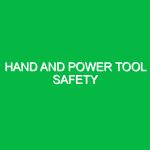Introduction
Silica dust is tiny particles of silica, which is a common mineral found in materials like sand, stone, concrete, and mortar. When these materials are cut, drilled, or ground, they release silica dust into the air. Silica Dust Hazard and Control refer to the practices and measures taken to manage and mitigate the risks associated with exposure to silica dust. This topic is highly relevant in the Health, Safety, and Environment (HSE) domain because exposure to silica dust can cause serious health problems.
Importance
Understanding Silica Dust Hazard and Control is crucial for maintaining health, safety, and environmental standards. Workers exposed to silica dust can develop serious diseases like silicosis, lung cancer, and chronic obstructive pulmonary disease (COPD). These illnesses not only affect the workers’ health but also lead to increased medical costs and lost workdays. By controlling silica dust, we can create a safer work environment, protect workers’ health, and comply with legal standards.
All Hazards
The hazards and risks associated with silica dust include:
-
Respiratory Diseases: Long-term exposure to silica dust can lead to silicosis, a lung disease that makes it hard to breathe and can be fatal. It can also cause lung cancer and other respiratory issues.
-
Eye Irritation: Silica dust can irritate the eyes, leading to redness, itching, and discomfort.
-
Skin Irritation: Direct contact with silica dust can cause skin irritation.
-
Environmental Impact: Silica dust can settle on plants and water sources, affecting the local ecosystem.
Safety Precautions
To control the hazards associated with silica dust, several safety precautions should be taken:
- Use water or ventilation systems to reduce the amount of dust in the air.
- Limit the number of workers exposed to dusty areas.
- Use enclosures or barriers to contain dust.
- Regularly clean work areas to remove dust.
- Provide proper training for workers on the dangers of silica dust and how to protect themselves.
Regulations and Standards
Various regulations and standards govern Silica Dust Hazard and Control:
-
OSHA (Occupational Safety and Health Administration): OSHA has set permissible exposure limits (PELs) for silica dust and requires employers to implement measures to reduce exposure.
-
NIOSH (National Institute for Occupational Safety and Health): NIOSH provides guidelines and recommendations for controlling silica dust exposure.
-
ACGIH (American Conference of Governmental Industrial Hygienists): ACGIH offers threshold limit values (TLVs) for various substances, including silica dust.
Tools and Equipment
Several tools, equipment, and technologies are used to control silica dust:
-
Wet Cutting Tools: These tools use water to reduce dust during cutting and grinding operations.
-
Vacuum Systems: Industrial vacuums can capture dust at the source, preventing it from becoming airborne.
-
Enclosures: Enclosures or barriers can contain dust within a specific area.
-
Air Purifiers: High-efficiency air purifiers can remove dust particles from the air.
Training and Education
Training and education are essential for effective Silica Dust Hazard and Control:
- Workers should be trained on the health risks associated with silica dust.
- Training should cover the proper use of protective equipment and safety measures.
- Regular refresher courses should be provided to keep workers updated on best practices.
Personal Protective Equipment (PPE)
Personal Protective Equipment (PPE) is crucial for protecting workers from silica dust:
-
Respirators: Respirators with appropriate filters can protect workers from inhaling silica dust.
-
Safety Glasses: Safety glasses or goggles can protect the eyes from dust.
-
Protective Clothing: Long-sleeved shirts and gloves can prevent skin irritation.
Emergency Preparedness
Being prepared for emergencies related to silica dust is essential:
- Have emergency procedures in place for silica dust exposure incidents.
- Ensure first aid kits are readily available and stocked.
- Train workers on emergency response procedures.
- Conduct regular drills to ensure everyone knows what to do in an emergency.
Workplace Design
The design of the workplace can significantly impact safety concerning silica dust:
- Design work areas to minimize dust generation and accumulation.
- Use materials and processes that produce less dust.
- Ensure proper ventilation to remove dust from the air.
- Implement dust control measures like barriers and enclosures.

